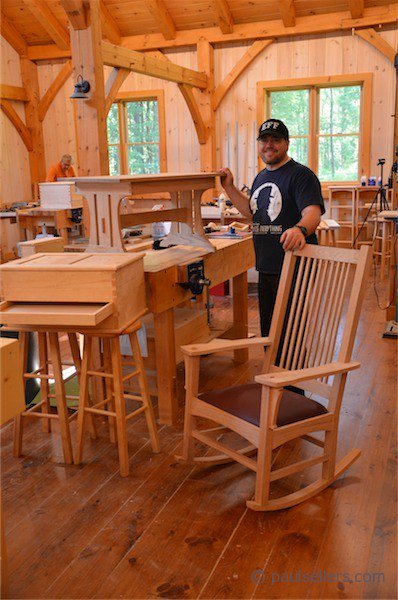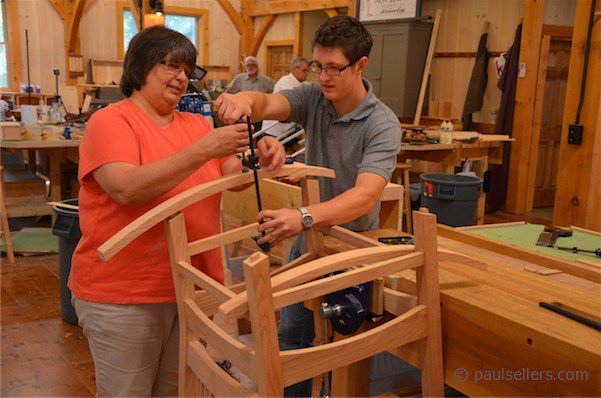Starting Out On Your Own – The Next Five Questions
My notes ramble on because I am trying to put myself in a position I may never have been in. In the last set of questions here I asked you to examine yourselves truthfully to see what support you had, what skill sets you already have, what type of woodworker you wanted to be and how you rated your abilities with regard to any and all types of equipment you might need in running your would-be business.

Phil works with me. He’s becoming his ambition. We help each other.
Question 6:
In question one I asked what kind of woodworker do you feel you want to be. The answer may or may not be clear to you and you should be prepared to shift unless you were in absolute certainty. Sometimes we have looked at other woodworkers and their lifestyle. Considering the lifestyle of others you may or may not personally know have you considered exactly what do you base your desire on? Write down a sentence or two and think through how you arrived at your vision for your future life.

Question 7:
If you have decided to start as a part time woodworker, how does that tie in with your present work? Do you have time to make and are you wanting to make to sell or just develop the skills you need? This will directly impact your life because if you are making to sell then you must have sufficient stock to display at wherever you have chosen to sell. What would you envisage making if you were going to hold your first presentation of work be that at a craft show, a gallery or studio or opening the doors of your own venue? Answering this question will help you prepare a plan. A plan that will give you the scope and sequence you need to hold your open house.

Question 8:
I don’t think that new woodworkers should be intent on taking commissions straight of the bat. The expectation may be too unrealistic unless you’ve trained for it, but they can take honest work to sell at a craft show or such. What you make can be large or small. If it’s furniture, half a dozen pieces can speak for themselves. If it’s a new bird feeder design, you may need 200. Have you decided what you want to make as your very own opening presentation?

Question 9:
Developing pieces, designs, involves design work be that yours or someone else’s. These designs define who you are and impact people when you present them. What designs would you make and what steps would that take for you and your family?
Question 10:
There are many different angles for people to view your life from and what you will be doing. You have family and friends, work colleagues and others associated with your life to say nothing of other show vendors, competitors, clients and customers. How do you think people will accept you when you start?


Hey Paul, thanks for the cameo. I really am appreciating this series and your thought provoking questions. In a month or two when I get a little settled in my new place, I’m going to thoroughly re-read the series and start figuring out the answers to your questions for myself and family.
Your Granddads neighbour sounds like me as an apprentice. I made stools on concrete patios with no bench, carried my tools in a bass on the handlebars and made whatever it took to make a living. One thing I had that these guys reading here didn’t have was training. I had an apprenticeship. I also lived in a culture that didn’t buy everything from Asia and that had villages and towns where people had a ‘man’ that came to do work. Those days are long gone, but I think with the right strategy some, many, can find their niche as I did.
LOL even ikea stuff is made in asia now….and it was the scandinavians who really pioneered post ww2 furniture design…
The man who I mentioned before, he was a college tutor but of the old school-he had a proper apprenticeship. I came into woodworking later on in life after various “disasters”, but he was, and still is a major influence on me-his methods are very similar to yours. A favourite saying of his was “begin to think like a joiner” and also “if the rods right the job will be right”…. …LOL anyway Brian got a message one day (he did foreigners at weekends) can you come and fix my greenhouse? Oh yes of course no problem, when he got there with his bass and 2 horses, the “greenhouse” turnned out to be 80 foot long…..and about half of the glass was damaged after a storm….needless to say he finished the job!
A few weeks ago I finished a massive-ish (3 cubic metre) framed log store, it is made up of 6 4×4 posts and 6×2 plates with drawbored mortice and tennon joints, inset braces, cut roof, clad with cedar shingles, bronze nails, set on 6 concrete pad stone’s. A bloke was visiting one morning, saw it and said, Thats brilliant. You should make them to sell, even I could sell those mate….
The thing is I thoroughly enjoyed every single part of that job, it was all done by hand-I especially liked working with the cedar shingles, and its hard to describe the pleasure of the rafters just dropping perfectly into place with no gaps. But I lack speed. Does real speed come after much practise or is it down to thorough planning?
cheers Jonathan
Hi Jonathan,
It sounds as though ypu went to a lot of trouble to make a good job. I think people don’t always understand but they somehow feel the effort you put in.
The more you do the more you become efficient. That’s important and so too is good planning, which means seeing ahed into the projects and trying to anticipate the sequence of work, where to get the right materials and so on. I keep a notebook of every job I do. This can save time down the road. I keep phone numbers in the notebook and can refer back to it.
I find that speed is very dependent on my frame of mind. If I am focussed things travel well. If there is a lot of ‘busy’ non productive stuff going on upstairs in the attic then a bit of timeout might be required. Having a lot of hands on experience certainly helps, especially with confidence, but having access to people like Paul who have been actively thinking and applying sound methodology to a particular area can be a definite ‘speed’ enhancer. Paul, you have nailed it with the comment ‘people don’t always understand but they somehow feel the effort you put in’ because they actually take the time,I think, to really take in the object that is now tangible in front of them. My last job involved repairing and extending returns on sections of skirting. The best way to ensure some continuity in line and accommodate the out of square and out of plumb existing timberwork was hand tool work, scribing and using some of the refined techniques that Paul has been so good to show. It was all quite fiddly (the second hand skirting that matched needed 20+ relieving cuts on its back to flatten it without splitting lengthways) but the client expressed a calm gratitude that made it all worthwhile on top of it being a ‘flowing’ job experience. I really don’t think I would have known where to start 10 years ago, but I would have had a crack and expected to wear the cost given the inefficient manner I probably would have approached it with. You definitely live and learn when you need to make a living.
Great posts, Paul. Very thoughtful, and even more helpful. Thank you.
Hi Erik, Hope you are Ok. Would have liked to see you in NY but maybe next time.